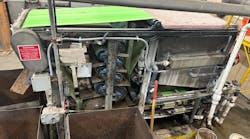The Birmingham Wastewater Treatment Plant in Kansas City, Mo., is an activated sludge treatment facility that processes 12.4 million gal of wastewater a day. The facility processes and receives 21,000 dry tons of sludge each year, which is pumped into sludge holding basins.
For the last few years the plant, in partnership with the city, has participated in an innovative recycling project, where sludge has played a major role. Its use as fertilizer on land adjacent to the treatment plant has started to convert the area into forest. This process appears to be an environmentally sound, cost-effective solution to sludge disposal.
Initial problems
But there was a time when processing the sludge was more a nuisance than an asset. Plant operators were constantly dealing with maintenance problems caused by debris clogging the sludge pumps. Industrial and commercial operations near the plant were the main culprits, discharging large quantities of cellophane, plastic bags and other solid waste into the flow. To complicate matters, the facility’s existing grinders were not performing adequately and needed to be replaced.
Franklin Miller was called to provide a solution and conduct a thorough system review. Based on the recommendations given by Franklin Miller, the plant installed six Taskmaster TM8500 Series inline grinders in front of each primary and transfer sludge pump. According to the manager of the facility, it was a very good decision.
“The grinders have performed extremely well and have done a good job in protecting the pumps. We are also happy with the ease of maintenance and replacement,” according to an official at the Birmingham Wastewater Treatment Plant.
The solution
The inline grinders effectively reduce tough sewage and sludge solids to fine particles directly in pipeline systems. Along with innovative Cutter Cartridge technology, these grinders feature convenient drop-in housing.
This unique design allows for fast and easy removal of the entire cutter mechanism for periodic maintenance without sacrificing unit strength. These powerful twin shaft grinders employ one-piece Cutter Cartridges that replace banks of weak individual cutters and spacers. The result is a high strength, durable grinder with a remarkable resistance to cutter and spacer cracking. This design dramatically increases unit strength, reduces maintenance time and eliminates the need for cutter stack re-tightening.
The TM8500 has two counter-rotating stacks that intermesh at close clearance to shear and shred solids into fine bits. One shaft feeds solids to the center of the unit while the other shreds them. The output achieved is easily processed by downstream equipment such as pumps, centrifuges, and belt filter presses. The Taskmaster can be successfully installed in sewage treatment plants, sludge lines, pumping stations, roadside or runway sanitary facilities, institutional waste, or small solid waste applications. It is supplied for open channel or in-line applications. The units are available for 4 to 24 in. pipe sizes.
Sondra Sommer is the marketing and communications manager for Franklin Miller. She can be reached at 973/535-9200, ext. 123 or by e-mail at [email protected]

